Coinbase Statistics By Revenue And Users (2025)
Updated · Jul 02, 2025

Table of Contents
Introduction
Coinbase Statistics: In 2024, Coinbase Global, Inc., the largest U.S.-based cryptocurrency exchange, transformed significantly and brought about such growth. According to the company, revenue and trading volumes during this period have seen great increases that reflect the dynamic nature of the cryptocurrency market.
This article gives Coinbase statistics, focusing on key financial measures, user interaction, and strategic innovations.
Editor’s Choice
- According to Coinbase statistics, in 2024, Coinbase experienced huge growth, including a large jump in revenue and trading volumes, as is generally the case in the fast-moving environment of the cryptocurrency market.
- Though still one of the biggest cryptocurrency exchanges globally, Binance faced a significant trade fight at the end of November 2023, resulting in a US$4 billion settlement and the resignation of its CEO.
- Coinbase’s revenue has been variable over the years. It recorded an evenue of US$7.8 billion in 2021 but dropped to US$2.9 billion in 2023.
- In 2024, the rebound occurred, and the company recorded US$6.2 billion, thanks to more trading activities and growth in subscription services.
- Coinbase statistics show that monthly transacting users fluctuated but rose to 8 million in Q1 2024, recovering from a low of 6.7 million in Q3 2023. The biggest user engagement was 11.4 million in Q4 2021.
- With more than 100 million verified users by 2022 and achieving 110 million by the end of 2022, Coinbase proved its consistent growth rate.
- Assets on the platform attained a record high of US$334.71 billion in Q1 2024, signaling an impressive recovery from a plummet to US$80.45 billion as low as Q4 2022.
- The retail trading volume reached US$56 billion in Q1 2024, reflecting a strong rebound from US$29 billion in Q4 2023. The peak encountered by retail participants was US$177 billion in Q4 2021 but had a fall owing to the market slump in 2022 and 2023.
- Adding cryptocurrency to a conventional 60/40 portfolio from April 2019 to March 2024 enhanced total returns and risk-adjusted performance with just marginally higher volatility and maximum drawdowns.
- Coinbase statistics state that a 1% allocation to Coinbase Core improved total returns from 33.30% to 39.63% and the Sharpe ratio from 0.41 to 0.50. If the allocation increases to 5%, the total return will increase to 67.03% with a Sharpe ratio of 0.78, which indicates improved performance on the total return.
Largest Cryptocurrency Spot Exchanges

(Reference: statista.com)
- Coinbase statistics show that Binance was the largest cryptocurrency exchange globally in 2024, with trading volumes compared to Bybit or OKX.
- However, Binance.US, Binance TR, and Binance.KR were excluded from the trading volumes. Citing its Cayman Islands location, it was under scrutiny by the U.S. Securities and Exchange Commission (SEC), engaging in a major legal battle in November 2023.
- Binance was one of the exchanges leading the global trading volume; however, it was not the most popular one among consumers in the United States. Binance, after settling with the U.S. authorities in November 2023 to pay a settlement fine of US$4 billion—one of the largest corporate fines in U.S. history-generated international interest.
- The Department of Justice had been investigating the company for years over allegations of not preventing money laundering and fueling a growth in crypto-related fraud.
- As part of the settlement agreement, Changpeng Zhao, the founder and CEO of Binance, already pleaded guilty and would step down, although he will still be the majority shareholder. In addition to these conditions, the U.S.
- Treasury will place Binance under surveillance for five years and require it to comply with measures for ensuring its exit from the U.S. market.
- The settlement quite coincidentally came at a time when the crypto trading volume increased to the highest levels in 2023.
- Much of this lift came from renewed interest from traders in FTT, an FTX token, with FTX being founded by Sam Bankman-Fried. Concerns about Binance led to investors trading out of Binance’s stablecoin BNB and into FTX’s stablecoin. Earlier this month, Coinbase did see stock weakening after its quarterly earnings report was released.
Coinbase Revenue
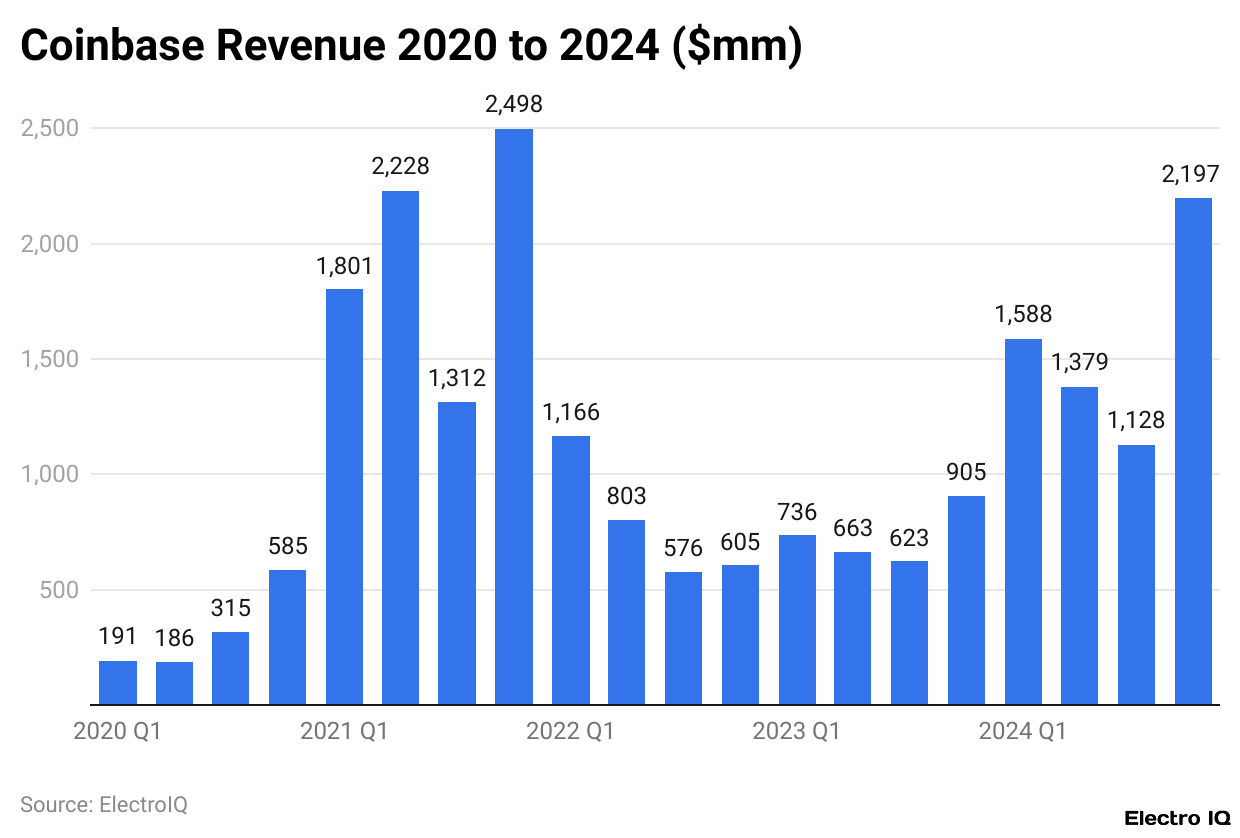
(Reference: businessofapps.com)
- Coinbase statistics state that it has certainly had a roller coaster of a revenue trajectory between 2017 and 2023, an outlook that basically replicates the broader outlook of the cryptocurrency market.
- In 2017, the company generated a revenue of US$0.9 billion on the back of the crypto boom in that particular year.
- Revenues fell tremendously with the market downturn to about US$0.5 billion each in 2018 and 2019.
- The company found an uptick in its revenues during 2020, which rose to US$1.2 billion with the renewed interest in digital assets. In 2021, that uptick gathered steam and exploded into a rise of US$7.8 billion in revenue, which was driven largely by crypto adoption and trading activity.
- The next two years saw another sharp fall, during which revenues went down to US$3.1 billion in 2022, followed by further dips to US$2.9 billion in 2023, thereby mirroring the overall crypto industry’s tailspin.
- The firm bounced back strongly in 2024, as Coinbase generated US$6.2 billion in revenue. Increased trading activities, recovering cryptocurrency prices, and growth in subscription and services revenue drove this boom.
- Coinbase’s past revenue volatility, however, is indicative of its resiliency and adaptability to an ever-changing market.
Coinbase Monthly Transacting Users
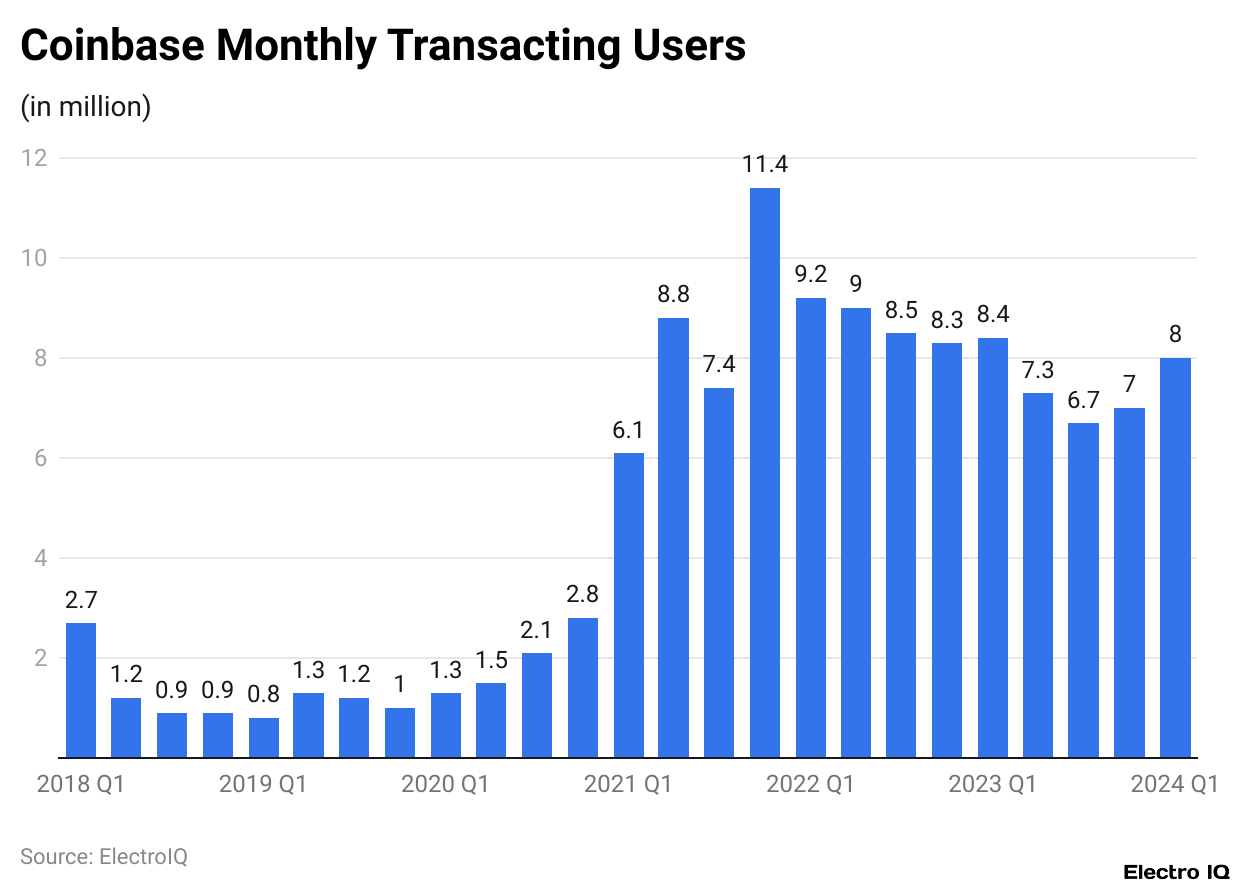
(Reference: backlinko.com)
- Coinbase statistics show that Coinbase reported 8 million monthly transacting users (MTUs) in Q1 of 2024, up from 7 million MTUs in the previous quarter.
- The activity of the platform in 2023 shows fluctuations across its user base, with MTUs going from 8.4 million in Q1 to 6.7 million in Q3 to marginally increasing to 7 million in Q4.
- Compared to 2023, the user engagement on Coinbase was higher in the preceding year, starting with 9.2 million MTUs in Q1, slightly dropping to 9 million in Q2, further decreasing to 8.5 million and 8.3 million in Q3 and Q4, respectively. This downward trend was in line with the general slowdown of cryptocurrency trading activities after the historically high levels of 2021. 2021 was a great growth year for Coinbase in terms of users.
- Monthly transacting users stood at 6.1 million in Q1 and shot up to 8.8 million in Q2. Although these figures dropped to 7.4 million in Q3, they hit an all-time high in Q4 with 11.4 million, confirming solid market activity and interest in cryptocurrency.
- Coinbase began with 1.3 million users in Q1 2020 and grew to 1.5 million in Q2. Engagement grew markedly in the second half of the year, with 2.1 million MTUs posted in Q3 and 2.8 million in Q4, which laid the groundwork for explosive growth in 2021.
- Monthly transacting users hovered between 800,000 and 1.3 million for much of 2019.
- A similar pattern was observed in 2018, with a peak of 2.7 million MTUs in the first quarter, followed by a steep decline to 1.2 million in the second quarter and further decreases to 0.9 million in the third and fourth quarters, in alignment with the cryptocurrency bear market prevailing at that time.
Coinbase Verified Users
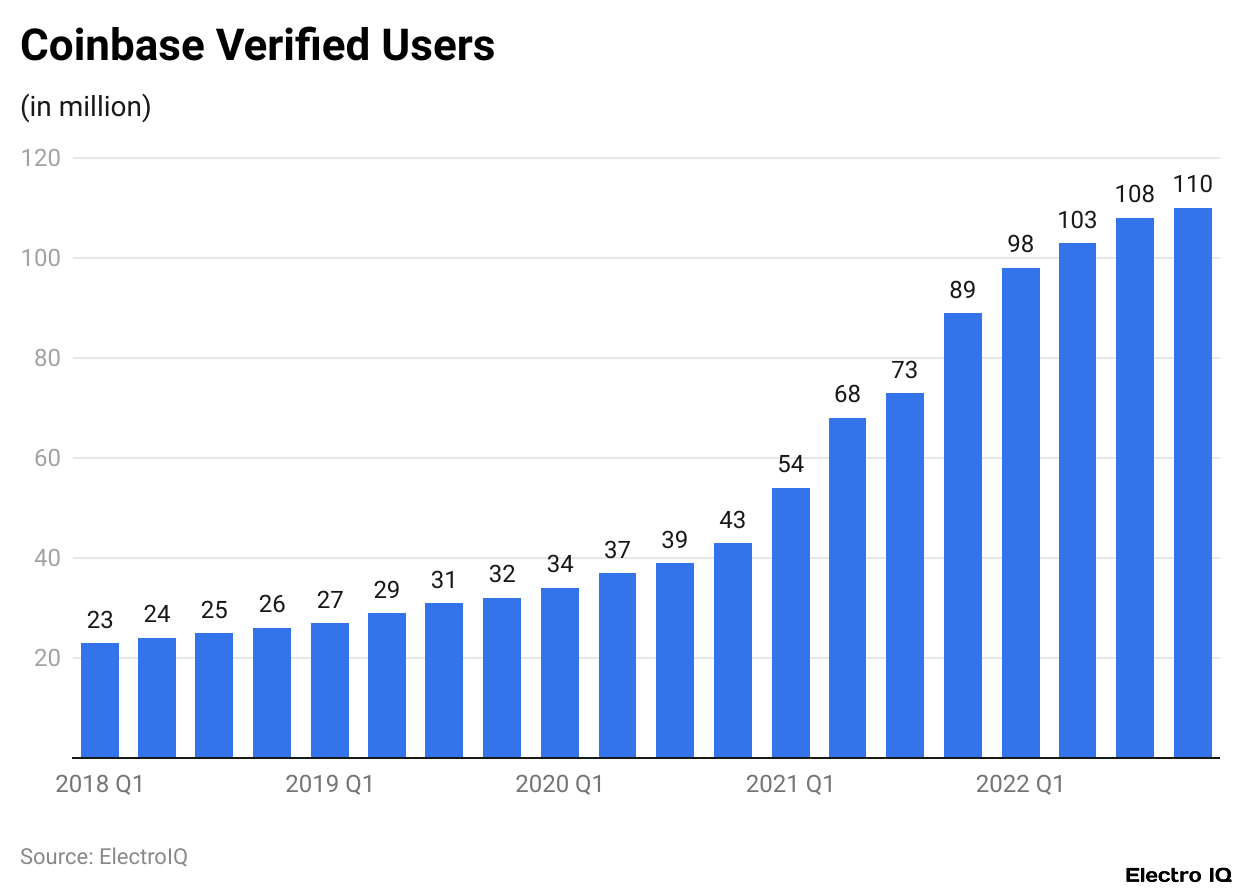
(Reference: backlinko.com)
- Coinbase statistics show that Coinbase had 23 million verified users in Q1 of 2018, which history shows grew steadily each quarter.
- By the end of 2018, the platform recorded a total of 26 million users. The growth continued smoothly through 2019, reaching 32 million by Q4.
- The increase overtook itself in the following two years, with registered numbers increasing from 34 million in Q1 2020 to 43 million by year-end 2020.
- The year 2021 saw a truly spectacular hike in the number of users, particularly Q1, bringing an increase to 54 million users.
- The surge continued, with Coinbase registering 68 million in Q2. It peaked enormously by the end of the year in 2021, with 89 million users.
- In 2022, growth continued but at a slower pace. The platform reached 98 million verified users in Q1 and crossed 100 million by Q2.
- By the end of 2022, Coinbase had 110 million verified users, indicating gradual adoption, notwithstanding variations in the market.
- These historical insights indicate Coinbase’s prowess in acquiring users through the years, positioning it as one of the largest cryptocurrency exchanges in the world.
Coinbase Platform Assets
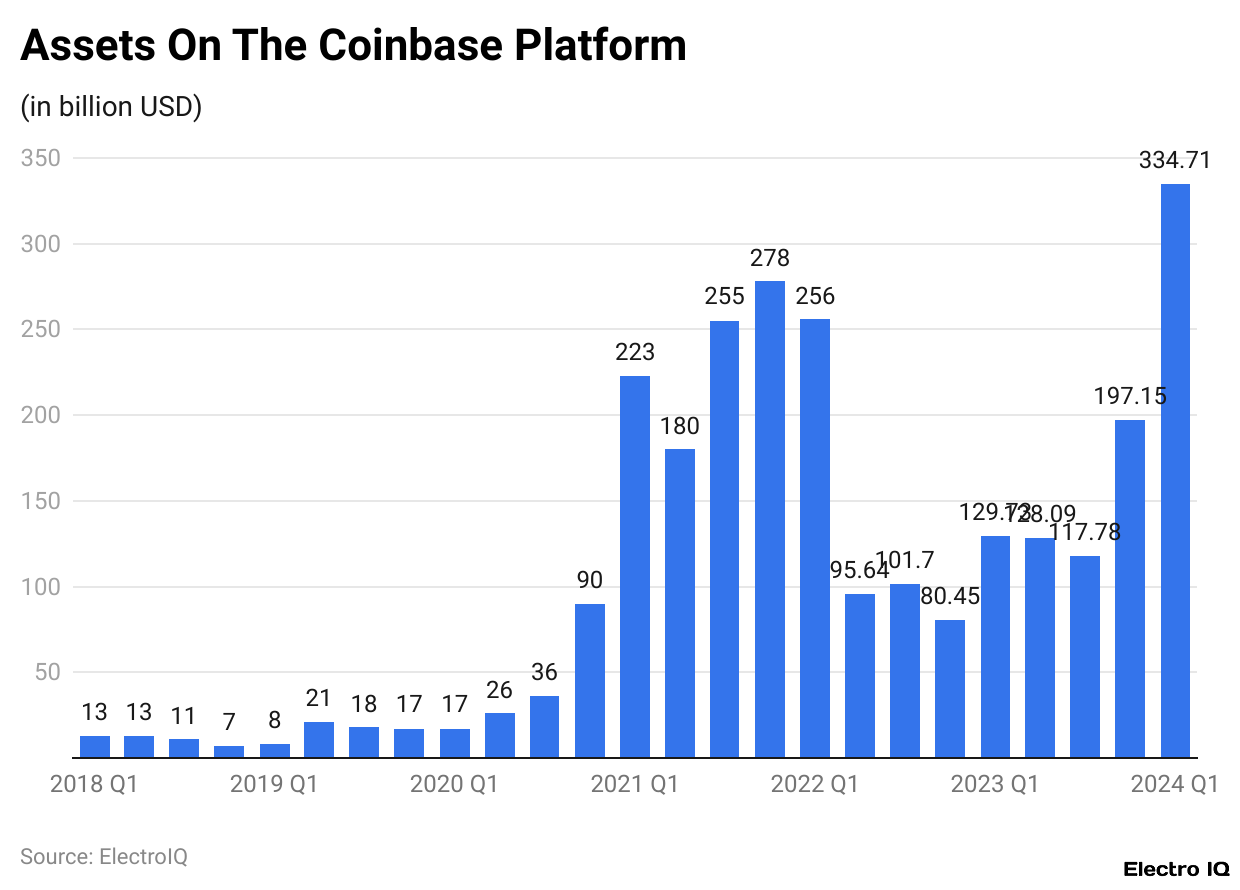
(Reference: backlinko.com)
- Coinbase statistics reveal that the total dollar amount of assets at Coinbase reached a record high of US$334.71 billion in the first quarter of 2024 compared to the US$197.15 billion reported in the last quarter of the previous year.
- The increase signifies a growing trend in investor confidence towards the platform and holds good promise for the market as a whole.
- By the end of 2023, assets had started at US$129.73 billion in Q1 before falling to US$117.78 billion in Q3 and recovering to US$197.15 billion in Q4, showing an impressive range. 2022 was a year of decline, with assets dwindling from US$256 billion in Q1 and down to anemic levels of US$80.45 billion by the fourth quarter due primarily to general market downturns and declining crypto valuations.
- 2021 had a showing of very vibrant growth: assets went from US$223 billion in Q1 to a high of US$278 in Q4. This was the time of a very bullish market and increasing adoption of cryptocurrencies.
- By mid-2022, however, assets dropped sharply to US$95.64 billion in Q2, reflecting the considerable correction in the market and volatility. The earlier years show a constant increase in assets on Coinbase, punctuated by sporadic dips.
- Assets on the platform grew from US$17 billion in Q1 to US$90 billion in Q4 in 2020, gaining by the mainstream adoption of digital currencies the preceding year, 2019, when assets oscillated from US$8 billion in Q1 to US$21 billion in Q2 and then averaged around US$17 billion at the close of the year.
- Earlier still, dollar-holding Coinbase netted US$13 billion in asset values at the beginning of 2018. However, this declined to US$7 billion by Q4 of that year, following a downturn in the crypto market after the bullish run of 2017.
- This trend over the years paints a picture of how volatile the crypto industry is while also proving the capability of Coinbase to recover and grow, especially during periods of good market momentum.
Coinbase Retail Trading Volume
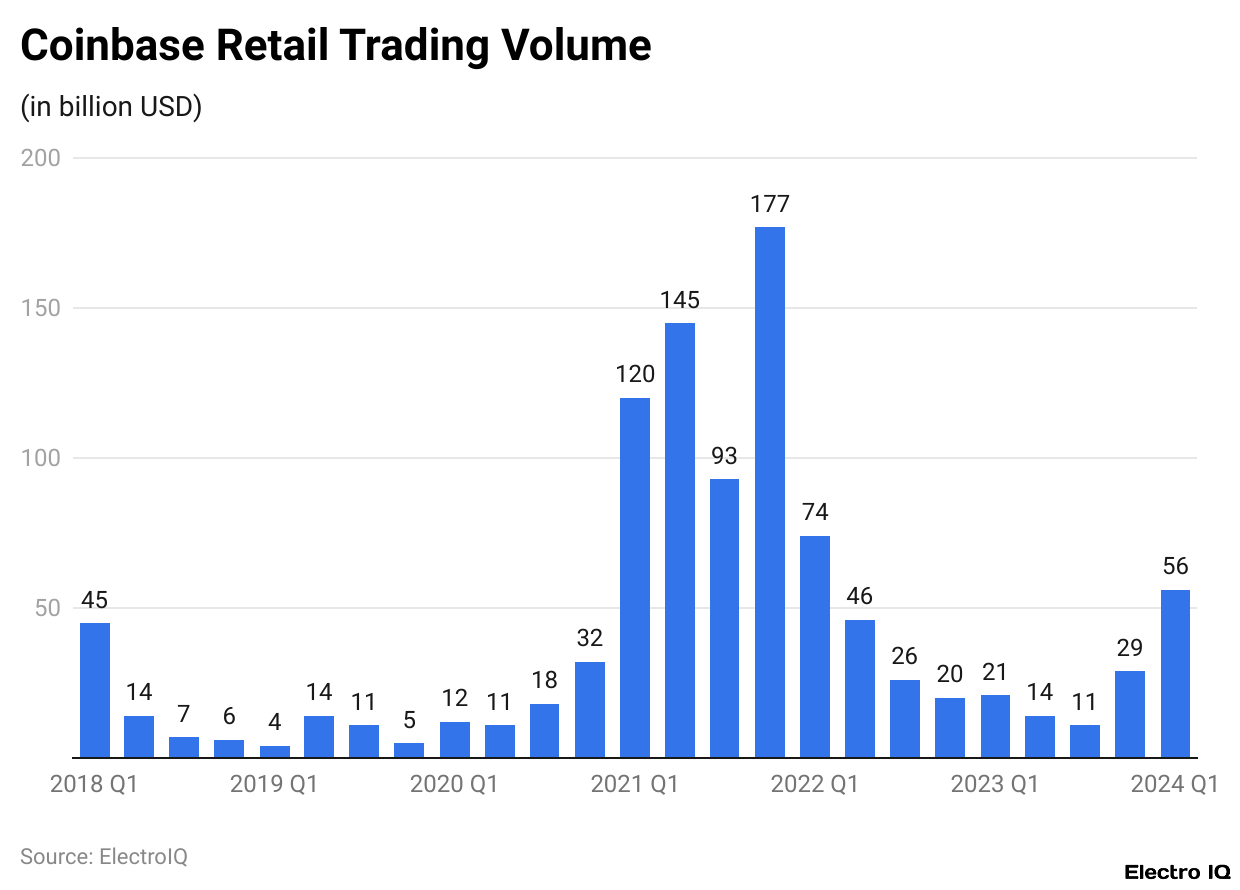
(Reference: backlinko.com)
- According to Coinbase statistics, Coinbase’s retail trading volume in the first quarter of 2024 would be at US$56 billion, only or just 17.95% of total trading activities. This was a marked increase from retail trading’s preceding quarter figures of US$29 billion, and part of the total trading activity during Q4 2023 was 18.83%.
- The figures show that the trend would have fluctuations over the course of 2023. In Q3, trading volume was US$11 billion (14.47%). This was followed by Q2, which recorded US$14 billion (15.22%), and finally by Q1 with US$21 billion (14.48%).
- The retail trading volume, on the other hand, earned throughout the year 2022: Q1 kicked off with US$74 billion (23.95%), then US$46 billion (21.2%) in Q2, lowered further to US$26 billion (16.35%) in Q3, and finally lowest at US$20 billion (13.79%) recorded in Q4.
- Losses correlated with the overall market and, of course, with waned retail participation in trading within the cryptocurrency space.
- The numbers released in 2021 had quite a different pattern, characterised by peak retail activities. US$120 billion was recorded in Q1 2021 (35.82%), and in Q2, it was followed with US$145 billion (31.39%).
- In the third quarter, it decreased to US$93 billion (28.44%) before recovering again in the last quarter to finally close with US$177 billion (32.3%), worth one of the stronger quarters in terms of retail participation by Coinbase.
- Retail trading volumes were significantly lower in 2020 but kept on growing all throughout the year. In the first part of the year, these figures totaled US$12 billion (40%), then had US$11 billion in the second quarter, increased to US$18 billion in the third (US$40%), and finally US$32 billion in the last quarter (US$35.95%) without deviating dramatically from the downward slope continued into retail trading volumes in 2019 compared to earlier years.
- Q1 gave a figure of US$4 billion (57.14%); Q2 jumped to US$14 billion (45.16%), then declined to US$11 billion in Q3 (40.74%) and US$5 billion in Q4 (35.71%).
- This is the continuation of the influence of a very favorable downward trend in 2018, where initial volumes were quite high in Q1 at US$45 billion (80.36%) but then dwindled considerably down to US$14 billion in Q2 (66.66%) and US$7 billion in Q3 (58.33%) and US$6 billion in Q4 (54.54%).
Coinbase Market Effects Of Adding Crypto To A 60/40 Portfolio April 2019 – March 2024
(Source: coinbase.bynder.com)
- The traditional 60-40 portfolio: between April 2019 and March 2024, superimposed over 60% ACWI (All Country World Index) and 40% US Aggregate Bonds, delivered a total return of 33.30% with an annual return of 5.92%.
- It has a volatility of 10.47%, a Sharpe ratio of 0.41, a Sortino ratio of 0.43, and a Calmar ratio of 0.28. The portfolio witnessed average increases of 2.65% during up months, with declines of 3.11% seen in down months.
- Coinbase statistics share that the maximum drawdown was 22.81%. Introducing a little cryptocurrency through Coinbase Core to the portfolio brought performance metrics upward. For example, when 1% Coinbase Core was added, the total return increased to 39.63%, whereas the annual return reached 6.91%, and the Sharpe ratio rose to 0.50.
- Volatility increased slightly to 10.56%, whereas the Sortino ratio improved to 0.52, and the Calmar ratio rose to 0.31. Average monthly returns in positive months increased to 2.84%, while down months experienced a decline at a slightly lower average of 2.95%.
- The maximum drawdown also slightly increased to 23.42% on the introduction of a 2% allocation to Coinbase Core. The total return, however, then goes up by almost 10%, to 46.16%, and the yearly return goes to 7.90%.
- The Sharpe ratio even went up to 0.58, while the Sortino ratio climbed to 0.60. Although the volatility now stands at 10.72%, the performance in terms of risk-adjustment has improved, as shown by the Calmar ratio of 0.34.
- Average returns on positive months were 2.91; negative months had a firm standing at 3.11, with a max drawdown of 24.04%. Allocating just 3% to crypto increased the total returns further to 52.91% and yearly returns to 8.87%.
- The Sharpe ratio reached 0.65, whereas the Sortino measure grew to 0.68. The portfolio would be slightly more volatile at 10.93, while Calmar is 0.37. Positive months averaged a 3.05% gain, while negative months had a fixed 3.13%. The maximum drawdown increased slightly to 24.65%.
- Lastly, at 4% exposure, total returns reached 59.86% and 9.85% annualised returns. The Sharpe ratio improved to 0.72, and the Sortino ratio reached 0.75. This condition increased the portfolio’s volatility to 11.19%.
- The risk-reward rating improved further with a Calmar ratio of 0.40. The portfolio accumulated an average of 3.28% in up months and faces a decline of -3.03% in down months. The maximum drawdown deepens to 25.27%.
- With a 5 % allocation to Coinbase Core, total returns jumped to 67.03%, with an annual return of 10.82%. The Sharpe ratio increased to 0.78, while the Sortino ratio improved to 0.81. Volatility increased to 11.50%, while Calmar reached 0.42.
- During these months, on average, the portfolio gained 3.36%, although it also had a slightly larger average loss of 3.24% in down months. The maximum drawdown increased further to 25.88%.
Conclusion
As per Coinbase statistics, Coinbas spectacular financial growth, significant product diversification, and far-reaching regulatory wins. The ability to more than double revenue demonstrates what a strong business model and an adaptable company it is in this fast-moving cryptocurrency era.
Having amassed users and with international regulatory initiatives under its belt, Coinbase has solidified its global leadership position and is poised to seize further opportunities and challenges that the developing digital asset domain will throw its way.
FAQ.
In 2024, Coinbase generated US$6.2 billion in revenue, marking a strong recovery from US$2.9 billion in 2023. This growth was driven by increased trading activity, higher cryptocurrency prices, and expansion in subscription services.
Coinbase’s verified users grew steadily, surpassing 100 million in 2022 and reaching 110 million by the end of that year. Monthly transacting users fluctuated, reaching 8 million in Q1 2024 after recovering from a low of 6.7 million in Q3 2023.
In November 2023, Binance reached a US$4 billion settlement with U.S. authorities over regulatory violations. Its CEO, Changpeng Zhao, resigned, and Binance was required to implement compliance measures while undergoing five years of monitoring.
Retail trading volume on Coinbase reached US$56 billion in Q1 2024, a significant recovery from US$29 billion in Q4 2023. However, it remained lower than the peak of US$177 billion recorded in Q4 2021.
Adding 1% Coinbase Core to a 60/40 portfolio increased total returns from 33.30% to 39.63% and improved the Sharpe ratio from 0.41 to 0.50. A 5% allocation further boosted total returns to 67.03% and the Sharpe ratio to 0.78, enhancing overall portfolio performance despite increased volatility.

Barry Elad is a passionate technology and finance journalist who loves diving deep into various technology and finance topics. He gathers important statistics and facts to help others understand the tech and finance world better. With a keen interest in software, Barry writes about its benefits and how it can improve our daily lives. In his spare time, he enjoys experimenting with healthy recipes, practicing yoga, meditating, or taking nature walks with his child. Barry’s goal is to make complex tech and finance information easy and accessible for everyone.










